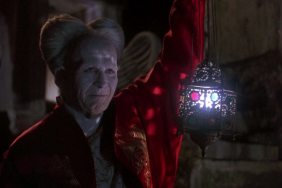A look back at the ill-conceived 2002 adaptation of Anne Rice’s Queen of the Damned
Visionary Irish director Neil Jordan’s mesmerizing 1994 adaptation of Anne Rice’s breakthrough 1976 bestseller Interview with the Vampire is rightly regarded as a Gothic horror classic and fine realization of the hyper-sensual world Rice birthed. It was an ideal marriage of sensibilities, as Jordan had already proved his abilities at creating lush, erotic dark fantasy with 1984’s The Company of Wolves, as well as gritty character drama with films like 1986’s Mona Lisa and 1992’s The Crying Game. And Rice had been a fan of all of these films and greatly approved of Warner Bros.’ decision to have Jordan on board, a decision made at her suggestion. She was less enthused by the casting of hot shot Hollywood actor Tom Cruise as her beloved “Brat Prince” Lestat, the rebellious, narcissistic blonde vampire who complexities propel the narrative of the story (though that first book is most assuredly Louis’ tale, the mopey vamp played in the film by Brad Pitt). She changed her tune when she saw just how good Cruise was in the role and how rich and evocative and full blooded the picture turned out to be.
But what about the sort of sequel? The misguided and comparatively impoverished Queen of the Damned?
With news breaking that rights to Rice’s extensive “Vampire Chronicles” series of books have reverted back to the author, we’re taking another look at that universally-reviled picture, a movie that actually has some value, making its glaring flaws and woeful missteps all the more unfortunate.
But first, some history, subjective and otherwise.
Rice followed Interview with the Vampire with 1985’s The Vampire Lestat, an epic novel that flipped the format of the first novel, which saw Louis telling the tale of the malevolent Lestat and the lethal antics he got up to. Here, Rice would give Lestat the chance to tell his tale. And what a tale. When this writer first read The Vampire Lestat, it was instant love. Told from the first person, the novel sees Lestat waking up from his self-imposed near-century sleep when he hears the blaring sound of ’80s hard rock and recognizes the music as vampiric in and of itself. He rises, drinks the blood of a victim or three and joins a local Louisiana band, taking over the group, becoming their front man, using his undead charisma and preternatural powers to propel them to super-stardom. And while his flashy, shameless antics anger the secret society of international vampires who see Lestat as a major threat to their existence, we are treated to the tragic, fascinating and wildly sexual story of Lestat’s youth as a wealthy French nobleman whose freewheeling charms attract an ancient vampire that turns him into what he would become.
When I read this book as a kid, a lover of horror and the idea of the vampire, I imagined I was Lestat; a bold, brave eternal youth whose hunger for blood was nowhere near his hunger for beauty and meaning in his long, long life. It was a breathless, addictive, fascinating read and I became a Goth because of its neo-romanticism. And I was not alone. The book was a bible to so many others I would meet on my own travels, not just a horror book but a work of philosophy and history laced with contemporary kink.
And the immediate sequel, Queen of the Damned, was almost as good, with Lestat’s rock music waking the dreaded Egyptian Queen Akasha, the first vampire who had been sitting in a state of marble until she was stirred by the sound and mind of this magnetic young ghoul. Akasha believes all men to be the root of evil and the cause of war and pain and aims to make Lestat her lover and her soldier, helping her to exterminate most of the planet’s living male mortals and allowing women to take control.

These two books read together are unlike anything else. Though they have been copied to death. And Rice of course would push Lestat into many other adventures (her latest Lestat book releases this week in fact!) as well as give many of the peripheral vampire characters their own books too. But man, The Vampire Lestat and Queen of the Damned… poetry.
Okay, so Neil Jordan’s Interview with the Vampire was a huge critical and commercial hit and Jordan was tapped to adapt The Vampire Lestat with Rice next, a project that died on the vine. Warner had a small window to prep their sequel before the rights lapsed back to Rice and so they began scrambling to make a sequel. Rice said she’d write it for free, taking a deferred payment. They weren’t interested. Neither were they interested in adapting the novel at all, deeming it too expensive and expansive to crush into a feature-length format. So instead, they opted to steal parts of the novel – chiefly the rock star angle and the meeting of Marius the vampire and skip right instead to adapt Queen of the Damned, while dropping that novel’s most fascinating element, that of the mass male genocide.
Producer Jorge Saralegui tapped Australian director Michael Rymer to direct, the budget was cut and the production was cheaply put together in Australia, with actor Stuart Townsend replacing Cruise as Lestat and rising pop star Aaliyah as Akasha, not to mention French actor Vincent Perez as Marius (and he’s awful, by the way). In the book, Lestat’s brand of rock and roll is a kind of blend of Bruce Springsteen and The Sisters of Mercy, but for the film, Nu Metal star Jonathan Davis of the whiny band Korn and composer Richard Gibbs (who had just come off of Big Momma’s House!) were stuck together to do the music and Davis was charged to write some songs for Lestat to sing. Instead of the majestic, operatic rock of the novel, we get… Korn.
And instead of a richly detailed, grandiose work of irreverent, imaginative Gothic melodrama we got a mostly static, flash-cut soaked cornball vampire movie that, despite its trimmings of the source material, still retained enough of a glut of underdeveloped plot threads and characters to turn the brief narrative into a jumbled mess.
And then, while in post, Aaliyah was tragically killed in a plane crash.
None of it felt right. It was, as Rice would say, an ill-conceived project from the get-go. A cash grab put together by tone-deaf producers and a greedy studio.
At this time, I was a junior publicist at Warner Bros. Canada and my job was to sell the movie. I, being a fan, took great interest in the film and, due to the Rice-led fan backlash, Saralegui started an online message board for the film wherein he would personally communicate with the fans to assure them how amazing the movie would be. I was on that site daily, for business and pleasure and it seemed the producer was genuinely excited about the picture. And he was swaying the fans. Many were hoping that maybe, just maybe, this thing might just work. Rice then met with Townsend and Rymer and she liked them both, found them sweet and sincere. And then she saw the movie and admitted there was enough of her story in there to warrant her keeping her name on the film.

And there is admittedly plenty of Rice in the film and Queen of the Damned does indeed have some things that work. Townsend is actually a great Lestat, with his weird accent and leering yet sweet, curious face lending humanity to the character in both immortal and mortal states of being. He’s lithe and looks great shirtless. The opening scenes showing his rise and attraction to the local goth rock band he eventually absorbs are terrifically weird and Gothic as is the scene where he goes bananas on the gypsy violin. And Rymer was most assuredly a fan. He just was not the right director for this film. Whereas Jordan brought a brooding, fluid sense of dread and pervasive gloomy sexuality to his first film. Rymer stages every scene with vampirie-centric seductions and attacks as cheap, dated rock video wanks, with skip-frames and time-lapses and hammy fang-flashes. The scope the story needs is never there either. When Lestat stages his big rock concert, the cheaply digitized crowd is laughably thin. And when Akasha rises, she doesn’t really do anything, save for wasting a lame vampire bar and zipping around the globe, mooning over Townsend. Aaliyah is good as Akasha, though. She’s beautiful and cat-like in her movements. How sad that we lost this bright talent so young and so senselessly.
When Queen of the Damned was finally released in early 2002, critics killed it, though it did fairly well at the box office. I saw it at the WB screening room a month prior to that release and I felt frustrated by the thought of what it could have been with more talented people behind the scenes. Instead of an epic tale of sex and death, what we got was a shoddy, silly and senseless cable movie. With Korn music. Ugh. I remember inviting a slew of my friends to the press screening, people who knew and loved the novels and I recall their faces upon exiting, ashen and angry. As they rightly should have been.
After a while, even Rice relented, admitting the movie was a failure and rejecting it, citing contempt for the fans, contempt for her words and general studio f**kery for bungling the job. And I’ve tried to revisit it myself. Countless times. I’ve tried to like it.
But then I read the books again and any goodwill that threatens to come a creepin’ quickly goes out for a smoke.
Truly, the only way to tell the story of The Vampire Lestat in a cinematic sense is to let it play long as a series, which is exactly what Rice is currently working on. Here’s hoping this happens.
See you in the Savage Garden…









